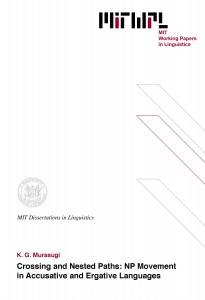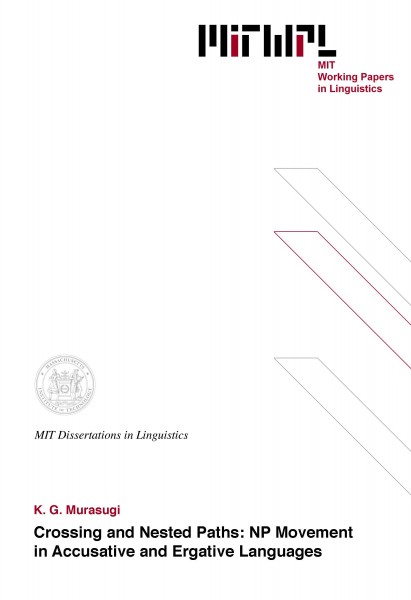Crossing and Nested Paths: NP Movement in Accusative and Ergative Languages
K. G. Murasugi, 1992
This thesis develops a theory of syntactic ergativity based on the Case feature requirements which motivate NP movement. In Chapter 1, I present an Ergative Parameter derived from the Case features of two functional heads, T(ense) and Tr(ansitivity). In an ergative language, the Case features of the higher T(ense) are strong, requiring movement to its SPEC at s-structure. In an accusative language, the Case features of the lower Tr(ansitivity) are strong, forcing s-structure movement to its SPEC. Economy Principles determine that it is always the subject, generated in SPEC VP, which raises to the SPEC of T or Tr (depending on the language) at s-structure. At LF, the object raises to the remaining SPEC position. This results in two types of movement: "Crossing Paths" in accusative languages, and "Nested Paths" in ergative languages. The two paths reflect the different Case and agreement patterns found in the two language types, as each functional head is associated with a particular Case: nominative/absolutive with T, and accusative/ergative with Tr. In an intransitive clause, the subject raises to SPEC TP in both types of languages.
Chapter 2 investigates consequences of the proposed theory for NP movement and verb raising in accusative languages. The topics relating to NP movement include expletives in SPEC TP, the EPP in infinitival clauses, and raising constructions in English. I also discuss verb fronting in V2 and VSO languages, proposing that this movement is required by a [finite] feature in C.
In Chapter 3, I provide evidence for my claim that ergativity involves the raising of the object (O) and intransitive subject (S) to SPEC TP, the position of transitive (A) and intransitive (S) subjects in accusative languages. I discusses properties shared by O/S in an ergative language, and A/S in an accusative language, such as the availability for relativization.
In Chapter 4, I investigate syntactic and semantic properties which group together S and A in both language types, claiming that they involve the notion of highest s-structure argument, and thematic roles. Chapter 5 discusses various issues pertaining to ergativity.
Thesis supervisor: Kenneth L. Hale
Title: Ferrari P. Ward Professor
Chapter 1 Two types of movement: crossing and nested paths 10
1.1 Introduction 10
1.2 The structure of clauses 13
1.3 Morphological features 15
1.3.1 Chomsky (1992) 15
1.3.2 A modified system of features 18
1.4 The ergative parameter and economy principles 23
1.5 Verb raising 28
1.6 Object raising 29
1.7 The Tr projection 32
1.8 NP movement in accusative and ergative languages 37
1.8.1 Transitive clauses 37
1.8.2 Intransitive clauses 40
1.8.2.1 Unergatives 40
1.8.2.2 Unaccusatives 41
1.8.2.3 Passives 43
1.8.2.4 Antipassives 44
1.8.3 Bi-clausal structures 45
Chapter 2 NP movement and verb raising in accusative languages 50
2.1 The content of SPEC TP 50
2.1.1 Overt expletives 51
2.1.2 Expletive pro 55
2.2 [-tense] and the EPP 59
2.3 Raising 64
2.4 Verb fronting languages: V2 and VSO 69
2.4.1 The feature [+/- finite] in C 70
2.4.1.1 V2 languages 70
2.4.1.2 VSO languages 74
2.4.2 V2 in embedded clauses 78
2.4.2.1 V2 languages 78
2.4.2.2 VSO languages 82
2.4.3 Question [+wh] in C 83
2.4.3.1 Matrix questions 83
2.4.3.2 Embedded questions 86
2.5 The inflected infinitive Portuguese and Italian 89
2.5.1 The [+finite] feature in C 89
2.5.2 [+wh] and inflected infinitives 94
Chapter 3 Evidence for syntactic ergativity 96
3.1 Verbal agreement 97
3.2 The scope of the nominative argument 102
3.3 The absence of transitive infinitives in Mayan 105
3.4 The inflected infinitive in ergative languages 111
3.4.1 Lezgian 112
3.4.2 Abkhaz 113
3.4.3 Inuit 114
3.4.4 Dyirbal 117
3.5 Deverbal nominals 122
3.6 The prominence of SPEC TP: relative clause constructions 125
3.6.1 Introduction 125
3.6.2 Relative clauses with [+tense] T 130
3.6.2.1 Accusative languages 132
3.6.2.2 Ergative languages 134
3.6.3 Relative clauses with [-tense] T 138
3.6.4 The restriction of relativization to nominative arguments 142
3.6.4.1 Accusative languages 145
3.6.4.2 Ergative languages 152
Chapter 4 The class of "subject": transitive and intransitive subjects 156
4.1 The notion of "subject" 156
4.2 Semantic properties of "subjects" 157
4.2.1 Agenthood 157
4.2.2 Imperatives 158
4.2.3 Jussive complements 160
4.3 Hierarchical structure 163
4.3.1 Reflexive binding 163
4.3.2 Possessor binding 165
4.3.3 Raising 166
4.3.4 Equi-NP deletion 169
4.3.4.1 Control 169
4.3.4.2 Obligatory pro binding 170
4.3.4.3 Topic chaining 173
Chapter 5 Issues in ergativity 178
5.1 Other analyses of ergativity 178
5.1.1 Deep structure hypothesis 178
5.1.1.1 de Rijk (1966) 179
5.1.1.2 Marantz (1984) 181
5.1.2 Obligatory case parameter 182
5.1.2.1 Levin and Massam (1985) 182
5.1.2.2 Bobaljik (1992) 185
5.1.3 Nominative object 189
5.1.3.1 Syntactic change 189
5.1.3.2 The unaccusative hypothesis: Bok-Bennema (1991) 191
5.1.3.3 Object raising: Bittner (in prep.) 193
5.2 Nominative and absolutive case 195
5.3 Morphological ergativity 199
5.3.1 Split ergativity 199
5.3.2 Uniform ergativity 205
5.4 Three functional projections 206

